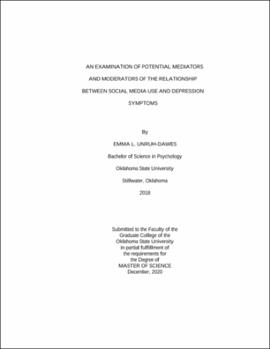| dc.description.abstract | Rates of depressive episodes are highest among emerging adults (aged 18-25) and the incidence of a major depressive episode has increased by 46%, 122%, 59%, and 39% for individuals aged 18-19, 20-21, 22-23, and 24-25, respectively, from 2009 to 2017 (Twenge, 2019). Because the rates of depression have been increasing over the same period as increases in the use of social media, social media has been implicated as a potential contributor to depression among emerging adults. Prior research has demonstrated an association between social media (SM) use and depression, but fewer studies examine the relationships between specific SM platforms despite potential differences in how these platforms affect mental health. The current study collected usage data for two SM platforms - Instagram and Twitter - directly from participants' smartphones and collected self-reported depression symptoms. Self-report measures of potential mediators and moderators of the relationship between SM and depression symptoms (social comparison, pessimism, negative SM experiences, and negative mood following SM use) were also administered. Participants also engaged in a manipulation and were assigned to one of four groups, either using Twitter for 5 minutes or 30 minutes or using Instagram for 5 minutes or 30 minutes. Results revealed no direct associations between Instagram use or Twitter use and depressive symptoms. However, there was a significant indirect effect of Instagram use on depressive symptoms through social comparison as well as a significant indirect effect of Twitter use on depressive symptoms through pessimism. Unexpectedly, 5 minutes of in-lab Instagram use resulted in lower social comparison scores. There were no significant findings regarding state angry mood, state sad mood, and state pessimism before and after Twitter use. The current study was the first to compare Instagram and Twitter use with our unique methodology. Our results suggest that increased Twitter use may be associated with increased depressive symptoms through increased pessimism, whereas Instagram may be associated with increased depressive symptoms through increased social comparison. Results emphasize the importance of examining social media platforms separately and investigating potential mediators of social media use and mental health symptoms. | |
